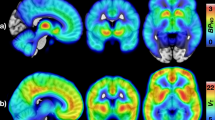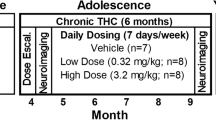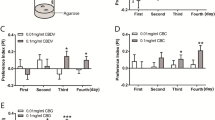Abstract
Strong functional interactions exist between endogenous cannabinoid and opioid systems. Here, we investigated whether cannabinoid–opioid interactions modulate motivational effects of food reinforcement. In rats responding for food under a progressive-ratio schedule, the maximal effort (break point) expended to obtain 45 mg pellets depended on the level of food deprivation, with free-feeding reducing break points and food-deprivation increasing break points. Delta-9-tetrahydrocannabinol (THC; 0.3–5.6 mg/kg intrapeitoneally (i.p.)) and morphine (1–10 mg/kg i.p.) dose-dependently increased break points for food reinforcement, while the cannabinoid CB1 receptor antagonist rimonabant (SR-141716A; 0.3–3 mg/kg i.p.) and the preferential mu-opioid receptor antagonist naloxone (0.3–3 mg/kg i.p.) dose-dependently decreased break points. THC and morphine only increased break points when food was delivered during testing, suggesting that these treatments directly influenced reinforcing effects of food, rather than increasing behavior in a nonspecific manner. Effects of THC were blocked by rimonabant and effects of morphine were blocked by naloxone, demonstrating that THC's effects depended on cannabinoid CB1 receptor activation and morphine's effects depended on opioid-receptor activation. Furthermore, THC's effects were blocked by naloxone and morphine's effects were blocked by rimonabant, demonstrating that mu-opioid receptors were involved in the effects of THC and cannabinoid CB1 receptors were involved in the effects of morphine on food-reinforced behavior. Thus, activation of both endogenous cannabinoid and opioid systems appears to jointly facilitate motivational effects of food measured under progressive-ratio schedules of reinforcement and this facilitatory modulation appears to critically depend on interactions between these two systems. These findings support the proposed therapeutic utility of cannabinoid agonists and antagonists in eating disorders.
Similar content being viewed by others
Log in or create a free account to read this content
Gain free access to this article, as well as selected content from this journal and more on nature.com
or
References
Abel EL (1975). Cannabis: effects on hunger and thirst. Behav Biol 15: 255–281.
Arnold JM, Roberts DC (1997). A critique of fixed and progressive ratio schedules used to examine the neural substrates of drug reinforcement. Pharmacol Biochem Behav 57: 441–447.
Arnone M, Maruani J, Chaperon F, Thiebot MH, Poncelet M, Soubrie P et al (1997). Selective inhibition of sucrose and ethanol intake by SR 141716, an antagonist of central cannabinoid (CB1) receptors. Psychopharmacology (Berl) 132: 104–106.
Berrendero F, Mendizabal V, Murtra P, Kieffer BL, Maldonado R (2003). Cannabinoid receptor and WIN 55 212-2-stimulated [35S]-GTPgammaS binding in the brain of mu-, delta- and kappa-opioid receptor knockout mice. Eur J Neurosci 18: 2197–2202.
Berry EM, Mechoulam R (2002). Tetrahydrocannabinol and endocannabinoids in feeding and appetite. Pharmacol Ther 95: 185–190.
Chen JP, Paredes W, Li J, Smith D, Lowinson J, Gardner EL (1990). Delta 9-tetrahydrocannabinol produces naloxone-blockable enhancement of presynaptic basal dopamine efflux in nucleus accumbens of conscious, freely-moving rats as measured by intracerebral microdialysis. Psychopharmacology (Berl) 102: 156–162.
Colombo G, Agabio R, Diaz G, Lobina C, Reali R, Gessa GL (1998). Appetite suppression and weight loss after the cannabinoid antagonist SR 141716. Life Sci 63: PL113–117.
Cooper SJ (2004). Endocannabinoids and food consumption: comparisons with benzodiazepine and opioid palatability-dependent appetite. Eur J Pharmacol 500: 37–49.
Cooper SJ, Kirkham TC (1990). Basic mechanisms of opioids' effects on eating and drinking. In: Reid LD (ed). Opioids, Bulimia and Alcohol Abuse and Alcoholism. Springer: New York. pp 91–110.
Cossu G, Ledent C, Fattore L, Imperato A, Bohme GA, Parmentier M et al (2001). Cannabinoid CB1 receptor knockout mice fail to self-administer morphine but not other drugs of abuse. Behav Brain Res 118: 61–65.
Cota D, Marsicano G, Lutz B, Vicennati V, Stalla GK, Pasquali R et al (2003). Endogenous cannabinoid system as a modulator of food intake. Int J Obes Relat Metab Disord 27: 289–301.
Croxford JL (2003). Therapeutic potential of cannabinoids in CNS disease. CNS Drugs 17: 179–202.
De Vries TJ, Shaham Y, Homberg JR, Crombag H, Schuurman K, Dieben J et al (2001). A cannabinoid mechanism in relapse to cocaine seeking. Nat Med 7: 1151–1154.
Di Marzo V, Goparaju SK, Wang L, Liu J, Batkai S, Jarai Z et al (2001). Leptin-regulated endocannabinoids are involved in maintaining food intake. Nature 410: 822–825.
Fernandez JR, Allison DB (2004). Rimonabant Sanofi–Synthelabo. Curr Opin Invest Drugs 5: 430–435.
Freedland CS, Poston JS, Porrino LJ (2000). Effects of SR141716A, a central cannabinoid receptor antagonist, on food-maintained responding. Pharmacol Biochem Behav 67: 265–270.
Gallate JE, Saharov T, Mallet PE, McGregor IS (1999). Increased motivation for beer in rats following administration of a cannabinoid CB1 receptor agonist. Eur J Pharmacol 370: 233–240.
Gonzalez S, Manzanares J, Berrendero F, Wenger T, Corchero J, Bisogno T et al (1999). Identification of endocannabinoids and cannabinoid CB(1) receptor mRNA in the pituitary gland. Neuroendocrinology 70: 137–145.
Gonzalez S, Schmid PC, Fernandez-Ruiz J, Krebsbach R, Schmid HH, Ramos JA (2003). Region-dependent changes in endocannabinoid transmission in the brain of morphine-dependent rats. Addict Biol 8: 159–166.
Gosnell B, Levine AS (1996). Stimulation of ingestive behaviour by preferential and selective opioid agonists. In: Cooper SJ and Clifton PG (eds). Drug Receptor Subtypes and Ingestive Behaviour. Academic Press: San Diego. pp 147–166.
Griffiths RR, Findley JD, Brady JV, Dolan-Gutcher K, Robinson WW (1975). Comparison of progressive-ratio performance maintained by cocaine, methylphenidate and secobarbital. Psychopharmacologia 43: 81–83.
Hao S, Avraham Y, Mechoulam R, Berry EM (2000). Low dose anandamide affects food intake, cognitive function, neurotransmitter and corticosterone levels in diet-restricted mice. Eur J Pharmacol 392: 147–156.
Harrold JA, Williams G (2003). The cannabinoid system: a role in both the homeostatic and hedonic control of eating? Br J Nutr 90: 729–734.
Herkenham M, Lynn AB, Johnson MR, Melvin LS, de Costa BR, Rice KC (1991). Characterization and localization of cannabinoid receptors in rat brain: a quantitative in vitro autoradiographic study. J Neurosci 11: 563–583.
Higgs S, Williams CM, Kirkham TC (2003). Cannabinoid influences on palatability: microstructural analysis of sucrose drinking after delta(9)-tetrahydrocannabinol, anandamide, 2-arachidonoyl glycerol and SR141716. Psychopharmacology (Berl) 165: 370–377.
Hodos W (1961). Progressive ratio as a measure of reward strength. Science 134: 943–944.
Holtzman SG, Jewett RE (1973). Stimulation of behavior in the rat by cyclazocine: effects of naloxone. J Pharmacol Exp Ther 187: 380–390.
Howlett AC (2002). The cannabinoid receptors. Prostaglandins Other Lipid Mediat 68–69: 619–631.
Jamshidi N, Taylor DA (2001). Anandamide administration into the ventromedial hypothalamus stimulates appetite in rats. Br J Pharmacol 134: 1151–1154.
Jarbe TU, Andrzejewski ME, DiPatrizio NV (2002). Interactions between the CB1 receptor agonist delta 9-THC and the CB1 receptor antagonist SR-141716 in rats: open-field revisited. Pharmacol Biochem Behav 73: 911–919.
Justinova Z, Tanda G, Munzar P, Goldberg SR (2004). The opioid antagonist naltrexone reduces the reinforcing effects of delta 9 tetrahydrocannabinol (THC) in squirrel monkeys. Psychopharmacology (Berl) 173: 186–194.
Kalinichev M, White DA, Holtzman SG (2004). Individual differences in locomotor reactivity to a novel environment and sensitivity to opioid drugs in the rat. I. Expression of morphine-induced locomotor sensitization. Psychopharmacology (Berl) 177: 61–67.
Kelley AE, Bakshi VP, Haber SN, Steininger TL, Will MJ, Zhang M (2002). Opioid modulation of taste hedonics within the ventral striatum. Physiol Behav 76: 365–377.
Kirkham TC (2003). Endogenous cannabinoids: a new target in the treatment of obesity. Am J Physiol Regul Integr Comp Physiol 284: R343–344.
Kirkham TC, Williams CM (2001). Synergistic efects of opioid and cannabinoid antagonists on food intake. Psychopharmacology (Berl) 153: 267–270.
Ledent C, Valverde O, Cossu G, Petitet F, Aubert JF, Beslot F et al (1999). Unresponsiveness to cannabinoids and reduced addictive effects of opiates in CB1 receptor knockout mice. Science 283: 401–404.
Low MJ, Hayward MD, Appleyard SM, Rubinstein M (2003). State-dependent modulation of feeding behavior by proopiomelanocortin-derived beta-endorphin. Ann NY Acad Sci 994: 192–201.
Mansour A, Khachaturian H, Lewis ME, Akil H, Watson SJ (1987). Autoradiographic differentiation of mu, delta, and kappa opioid receptors in the rat forebrain and midbrain. J Neurosci 7: 2445–2464.
Manzanares J, Corchero J, Romero J, Fernandez-Ruiz JJ, Ramos JA, Fuentes JA (1999). Pharmacological and biochemical interactions between opioids and cannabinoids. Trends Pharmacol Sci 20: 287–294.
Martin M, Ledent C, Parmentier M, Maldonado R, Valverde O (2000). Cocaine, but not morphine, induces conditioned place preference and sensitization to locomotor responses in CB1 knockout mice. Eur J Neurosci 12: 4038–4046.
Mascia MS, Obinu MC, Ledent C, Parmentier M, Bohme GA, Imperato A et al (1999). Lack of morphine-induced dopamine release in the nucleus accumbens of cannabinoid CB(1) receptor knockout mice. Eur J Pharmacol 383: R1–R2.
Matsuda LA, Lolait SJ, Brownstein MJ, Young AC, Bonner TI (1990). Structure of a cannabinoid receptor and functional expression of the cloned cDNA. Nature 346: 561–564.
McLaughlin PJ, Winston K, Swezey L, Wisniecki A, Aberman J, Tardif DJ et al (2003). The cannabinoid CB1 antagonists SR 141716A and AM 251 suppress food intake and food-reinforced behavior in a variety of tasks in rats. Behav Pharmacol 14: 583–588.
Munzar P, Tanda G, Justinova Z, Goldberg SR (2004). Histamine h3 receptor antagonists potentiate methamphetamine self-administration and methamphetamine-induced accumbal dopamine release. Neuropsychopharmacology 29: 705–717.
National Research Council (2003). Guidelines for the Care and Use of Mammals in Neuroscience and Behavioral Research. The National Academy Press: Washington, DC, USA.
Nencini P, Graziani M (1990). Opiatergic modulation of preparatory and consummatory components of feeding and drinking. Pharmacol Biochem Behav 37: 531–537.
Piomelli D (2003). The molecular logic of endocannabinoid signalling. Nat Rev Neurosci 4: 873–884.
Reisine T, Law SF, Blake A, Tallent M (1996). Molecular mechanisms of opiate receptor coupling to G proteins and effector systems. Ann NY Acad Sci 780: 168–175.
Robbins TW, Watson BA, Gaskin M, Ennis C (1983). Contrasting interactions of pipradrol, D-amphetamine, cocaine, cocaine analogues, apomorphine and other drugs with conditioned reinforcement. Psychopharmacology (Berl) 80: 113–119.
Roberts DC, Bennett SA (1993). Heroin self-administration in rats under a progressive ratio schedule of reinforcement. Psychopharmacology (Berl) 111: 215–218.
Rodriguez JJ, Mackie K, Pickel VM (2001). Ultrastructural localization of the CB1 cannabinoid receptor in mu-opioid receptor patches of the rat caudate putamen nucleus. J Neurosci 21: 823–833.
Rowland NE, Mukherjee M, Robertson K (2001). Effects of the cannabinoid receptor antagonist SR 141716, alone and in combination with dexfenfluramine or naloxone, on food intake in rats. Psychopharmacology (Berl) 159: 111–116.
Salamone JD, Correa M, Mingote S, Weber SM (2003). Nucleus accumbens dopamine and the regulation of effort in food-seeking behavior: implications for studies of natural motivation, psychiatry, and drug abuse. J Pharmacol Exp Ther 305: 1–8.
Schmelzeis MC, Mittleman G (1996). The hippocampus and reward: effects of hippocampal lesions on progressive-ratio responding. Behav Neurosci 110: 1049–1066.
Simiand J, Keane M, Keane PE, Soubrie P (1998). SR 141716, a CB1 cannabinoid receptor antagonist, selectively reduces sweet food intake in marmoset. Behav Pharmacol 9: 179–181.
Solinas M, Panlilio LV, Antoniou K, Pappas LA, Goldberg SR (2003). The cannabinoid CB1 antagonist N-piperidinyl-5-(4-chlorophenyl)-1-(2,4-dichlorophenyl)-4-methylpyrazole-3-carboxamide (SR-141716A) differentially alters the reinforcing effects of heroin under continuous reinforcement, fixed ratio, and progressive ratio schedules of drug self-administration in rats. J Pharmacol Exp Ther 306: 93–102.
Solinas M, Zangen A, Thiriet N, Goldberg SR (2004). Beta-endorphin elevations in the ventral tegmental area regulate the discriminative effects of delta-9-tetrahydrocannabinol. Eur J Neurosci 19: 3183–3192.
Spano MS, Fattore L, Cossu G, Deiana S, Fadda P, Fratta W (2004). CB1 receptor agonist and heroin, but not cocaine, reinstate cannabinoid-seeking behaviour in the rat. Br J Pharmacol 143: 343–350.
Tanda G, Goldberg SR (2003). Cannabinoids: reward, dependence, and underlying neurochemical mechanisms—a review of recent preclinical data. Psychopharmacology (Berl) 169: 115–134.
Tanda G, Pontieri FE, Di Chiara G (1997). Cannabinoid and heroin activation of mesolimbic dopamine transmission by a common mu1 opioid receptor mechanism. Science 276: 2048–2050.
Thornton-Jones ZD, Vickers SP, Clifton PG (2004). The cannabinoid CB1 receptor antagonist SR141716A reduces appetitive and consummatory responses for food. Psychopharmacology (Berl) (online); doi: 10.1007/s00213-004-2047-8.
Valverde O, Noble F, Beslot F, Dauge V, Fournie-Zaluski MC, Roques BP (2001). Delta9-tetrahydrocannabinol releases and facilitates the effects of endogenous enkephalins: reduction in morphine withdrawal syndrome without change in rewarding effect. Eur J Neurosci 13: 1816–1824.
Vigano D, Grazia Cascio M, Rubino T, Fezza F, Vaccani A, Di Marzo V et al (2003). Chronic morphine modulates the contents of the endocannabinoid, 2-arachidonoyl glycerol, in rat brain. Neuropsychopharmacology 28: 1160–1167.
Vigano D, Valenti M, Cascio MG, Di Marzo V, Parolaro D (2004). Changes in endocannabinoid levels in a rat model of behavioral sensitization to morphine. Eur J Neurosci 20: 1849–1857.
Williams CM, Kirkham TC (1999). Anandamide induces overeating: mediation by central cannabinoid (CB1) receptors. Psychopharmacology (Berl) 143: 315–317.
Williams CM, Kirkham TC (2002a). Observational analysis of feeding induced by Delta9-THC and anandamide. Physiol Behav 76: 241–250.
Williams CM, Kirkham TC (2002b). Reversal of delta 9-THC hyperphagia by SR141716 and naloxone but not dexfenfluramine. Pharmacol Biochem Behav 71: 333–340.
Williams CM, Rogers PJ, Kirkham TC (1998). Hyperphagia in pre-fed rats following oral delta9-THC. Physiol Behav 65: 343–346.
Yeomans MR, Gray RW (2002). Opioid peptides and the control of human ingestive behaviour. Neurosci Biobehav Rev 26: 713–728.
Acknowledgements
The research performed was supported by the Intramural Research Program of the National Institute on Drug Abuse, National Institutes of Health, and Department of Health and Human Services. We would like to thank Leigh Panlilio for comments on an earlier version of this paper.
Author information
Authors and Affiliations
Corresponding author
Rights and permissions
About this article
Cite this article
Solinas, M., Goldberg, S. Motivational Effects of Cannabinoids and Opioids on Food Reinforcement Depend on Simultaneous Activation of Cannabinoid and Opioid Systems. Neuropsychopharmacol 30, 2035–2045 (2005). https://doi.org/10.1038/sj.npp.1300720
Received:
Revised:
Accepted:
Published:
Issue date:
DOI: https://doi.org/10.1038/sj.npp.1300720
Keywords
This article is cited by
-
Metabolic and feeding adjustments during pregnancy
Nature Reviews Endocrinology (2023)
-
Cannabinoid receptor type 1 antagonists alter aspects of risk/reward decision making independent of toluene-mediated effects
Psychopharmacology (2022)
-
Morphine reduces the interest for natural rewards
Psychopharmacology (2022)
-
Cerebral μ-opioid and CB1 receptor systems have distinct roles in human feeding behavior
Translational Psychiatry (2021)
-
Multiple endocannabinoid-mediated mechanisms in the regulation of energy homeostasis in brain and peripheral tissues
Cellular and Molecular Life Sciences (2019)



